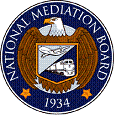Information contained in this publication is intended for informational purposes only and does not constitute legal advice or opinion, nor is it a substitute for the professional judgment of an attorney.
 In a move consistent with organized labor’s push for an accelerated collective bargaining process for airlines and railroads, the National Mediation Board (NMB) announced the implementation of its expedited mediation project. (pdf) The new program is designed ostensibly to move the mediation process – whose purpose is to resolve collective bargaining disputes in the airline and railroad industries – along. In a press release, Larry Gibbons, NMB Director for Mediation, said the program was in response to a report (pdf) issued in 2010 by the Dunlop II Committee, a joint labor-management committee formed to examine the internal functions, policies and procedures of the NMB and make recommendations for procedural or policy changes. Gibbons explained that the report “...recommended, among other things, that case management strategies be developed to help address [mediation] disputes in a timely and methodical manner.” From this general recommendation in Dunlop II, the NMB developed protocols for expedited mediation. The initiative stops far short of recommendations principally from unions for explicit time limits on mediation. Yet, the initiative works to dispel the perception held by some that mediation is an endless process.
In a move consistent with organized labor’s push for an accelerated collective bargaining process for airlines and railroads, the National Mediation Board (NMB) announced the implementation of its expedited mediation project. (pdf) The new program is designed ostensibly to move the mediation process – whose purpose is to resolve collective bargaining disputes in the airline and railroad industries – along. In a press release, Larry Gibbons, NMB Director for Mediation, said the program was in response to a report (pdf) issued in 2010 by the Dunlop II Committee, a joint labor-management committee formed to examine the internal functions, policies and procedures of the NMB and make recommendations for procedural or policy changes. Gibbons explained that the report “...recommended, among other things, that case management strategies be developed to help address [mediation] disputes in a timely and methodical manner.” From this general recommendation in Dunlop II, the NMB developed protocols for expedited mediation. The initiative stops far short of recommendations principally from unions for explicit time limits on mediation. Yet, the initiative works to dispel the perception held by some that mediation is an endless process.
Notably, expedited mediation under the NMB’s program comes only after both the carrier and the union jointly apply for mediation and concur on the use of expedited mediation. According to the NMB, participants must have “shown significant progress in direct negotiations.” An example of how progress could be deemed “significant” is if the parties present the agency with only a limited number of issues to be resolved. The NMB will conduct an initial assessment of the case’s appropriateness for expedited mediation and, if it accepts the matter, will “assist the parties in negotiation of a protocol agreement that will be used to guide expedited mediation and establish expectations.” According to the NMB, this agreement “will establish expectations and guide the expedited mediation process on a case-by-case basis.” The agency will closely monitor any case accepted into the program. If the process fails to result in an agreement, the NMB will have “complete discretion how to proceed” with the case.
Prolonged negotiations have been part of the fabric of NMB-mediated negotiations for some time. This new program may allow unions to exert pressure to accelerate the bargaining process, either through actual accelerated mediation or more subtle pressure on the NMB by virtue of having made a request for expedited mediation that is rejected by the carrier. By the same token, carriers could also use this expedited program to their advantage in certain instances. Unions may also attempt to distort the significance of this program and point to the possibility of expedited mediation in organizing campaigns – for example, in response to factual information provided by carriers on the typical length of time required to arrive at an initial collective bargaining agreement.
The three-member NMB has received a great deal of criticism from the business community since its adoption last year of a final rule (pdf) that changed the agency’s 75-year-old representation election process. Under the terms of the new rule, voting outcomes are determined by the majority of those who actually vote, effectively making it easier for unions to win elections in the rail and air industries. The long-standing prior approach based the voting outcome on a majority of employees eligible to vote in the representation elections. As a result, employees choosing not to participate were effectively viewed as “no union” votes. This departure has been challenged in litigation and proposed legislation, and the NMB’s conduct in the regulatory process leading to the new voting rule is also the subject of a Congressional hearing.


